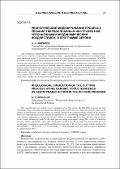| dc.contributor.author | Жигалов, А. Н. | ru_RU |
| dc.coverage.spatial | Гомель | ru_RU |
| dc.date.accessioned | 2020-07-15T06:51:50Z | |
| dc.date.available | 2020-07-15T06:51:50Z | |
| dc.date.issued | 2020 | |
| dc.identifier.citation | Жигалов, А. Н. Реологическое моделирование процесса резания твердосплавным инструментом, упрочненным аэродинамическим воздействием, в программе DEFORM / А. Н. Жигалов // Вестник ГГТУ им. П. О. Сухого: научно-практический журнал. - 2020. - № 2. - С. 15-24. | ru_RU |
| dc.identifier.uri | https://elib.gstu.by/handle/220612/22908 | |
| dc.description.abstract | Для ускоренного проектирования и исследования нового наукоемкого процесса – метода аэродинамического звукового упрочнения твердых сплавов – разработаны научные основы имитационного моделирования процесса резания твердосплавным инструментов в программном продукте DEFORM. Созданы на основе решения контактной задачи теории упругости для реологических процессов аналитические зависимости для определения сил резания и получены эмпирические зависимости износа по задней поверхности от времени резания, которые являются базовыми в созданной реологической модели процесса износа при прерывистом резании. Результаты моделирования давления, скорости и температуры, износа, сил резания позволили изучить основы нового процесса аэродинамического
упрочнения и показали, что обработка твердыми сплавами, упрочненными данным методом, деталей из стали 45 (v = 158,3 м/мин; s = 0,12 мм/зуб; t = 1,0 мм) способствует за счет снижения износа увеличению стойкости инструмента приблизительно на 60 %. | ru_RU |
| dc.description.abstract | New accurate solutions of the wave equation with energy sources with cubic and quadratic nonlinearities has been studied. The dynamics of nonlinear thermal waves scattering in opposite directions has been
considered. It is important to mention that the waves propagate along a spatially in homogeneous thermal
background. The process input parameters are estimated where an anomalous temperature response of the
medium is observed at the wavefront: heat application/abstraction gives decrease/increase in temperature. It is shown that the inversion of the “subsonic – supersonic” processes leads to the inversion of the temperature range location wherein the “negative heat capacity” phenomenon is observed. For a two-component
system, an example of the periodic appearance/disappearance of non-classical negative heat capacity states is presented. The examples of an accurate analytical description of a stationary 2D system of the reactiondiffusion type are given. It has been established that to a large extent the temperature variation nature depends on factors such as sign alternation of the source and quantitative relationship between linear and nonlinear summands in the expressions for the competing source functions. | en |
| dc.language.iso | ru | ru_RU |
| dc.publisher | ГГТУ им. П.О. Сухого | ru_RU |
| dc.subject | Аэродинамическое упрочнение | ru_RU |
| dc.subject | Аэродинамика | ru_RU |
| dc.subject | Реологическое моделирование | ru_RU |
| dc.subject | Резание | ru_RU |
| dc.subject | программа Deform | ru_RU |
| dc.subject | Аerodynamic hardening | ru_RU |
| dc.subject | Rheological simulation | ru_RU |
| dc.subject | DEFORM program | ru_RU |
| dc.title | Реологическое моделирование процесса резания твердосплавным инструментом, упрочненным аэродинамическим воздействием, в программе DEFORM | ru_RU |
| dc.title.alternative | Rheological simulation of the cutting process using carbide tools hardened by aerodynamic action in the deform program | ru_RU |
| dc.type | Article | ru_RU |
| dc.identifier.udc | 621.9 | |
